Smallpox. Later, general fever
In 1882 the Metropolitan Asylums Board (MAB) moved its smallpox hospital ships - the Atlas, the Endymion and the Castilia - from Deptford to new moorings at Long Reach, an isolated stretch of the River Thames about 17 miles (27 km) from London Bridge. The removal of the ships to their new location required the provision of a River Ambulance Service to ferry patients from central London. The following year a pier was constructed at Long Reach for the reception of smallpox cases from wharves to be built at Rotherhithe, Poplar and Fulham.
In 1883, despite considerable public objection due to the hostility and fear roused by smallpox, MAB purchased Acorn Wharf in Trinity Street, Rotherhithe, for £13,000. The 2 acre site had been chosen as a receiving station for the River Ambulance Service (RAS) because it had a "spacious and open river frontage and a foreshore sufficiently shelved to admit the construction of a floating pier ... but is also easily approachable from the land side by thoroughfares sufficiently broad to obviate any possibility of the ambulances conveying patients being delayed during the journey by congestion of traffic". It was also near Potter's Ferry Wharf, which MAB was using until its own Wharves were built.
A smallpox epidemic occurred during 1884-5, when there was only one ambulance steamer (the Red Cross) and before the wharves had been completed. MAB continued to use Potter's Ferry Wharf as a receiving station, but the Red Cross could only go along Acorn Wharf before or after high water until its floating pier was competed.
The floating pier was built, placed so that there was sufficient water for steamers to come alongside. It had a covered shed at the land end where the ambulances delivered the patients. The shed contained an examination room where patients were assessed as to their fitness to travel. If fit enough, they were transferred to a bed on the waiting paddle steamer.The ships usually ran once a day, but during epidemics worked non-stop. With a speed of 10 knots, the journey from the Acorn Wharf Receiving Station to Long Reach took between 90 to 120 minutes. Delays occurred during bad weather, when the steamers were unable to sail because of the thick fog which often enveloped the Thames, but these delays rarely lasted more than a few hours.
In 1885 Acorn Wharf was renamed South Wharf. By 1888 it had evolved into the major depot of the RAS; stores for the RAS and other Wharves were kept here and the steamers, when not running, were kept moored to the Benmore, a hulk purchased in 1887, to prevent vessels from being damaged by grounding at every tide (as they were when secured to the pier).
In 1893 two shelters were built at the Wharf to isolate dubious cases of smallpox, instead of transferring them to the South Eastern Hospital. These shelters consisted of corrugated iron buildings lined with wood. One had four separate rooms and the other two separate rooms. Each shelter had a separate Nurse's Duty Room. This development meant that the South Wharf was independent of the other MAB hospitals.
In 1895 the service was suspended for two weeks because of huge sheets of ice floating on the river following a big freeze. Patients were stranded at South Wharf, but fortunately there was no smallpox epidemic at the time. During 1895-1896 commodious staff quarters were built for the nurses and domestics who worked on the steamers and on the shore. In 1896 a 6-bedded hut was added for patients who arrived too late for immediate transportation to ships.
At the beginning of the century work began on a new land hospital - the Joyce Green Hospital - to replace the hospitals ships.
In 1901, just as another smallpox epidemic began, the Wharf was further expanded, with more female staff quarters, a residence for the Medical Officer, a receiving room, an isolation room and a bathroom being built. The male staff quarters were in a temporary building but, as the epidemic grew, more male staff quarters were needed. However, by 1906, road transportation was threatening the river service.
With the decline of smallpox, the river service was reorganised in 1913, with the South Wharf dealing with general fever cases while the North Wharf continued to receive smallpox cases.
By 1921 the South Wharf had expanded its land facilities and had 24 beds in various 'shelters' where patients could be kept overnight if necessary.
In 1930 the Metropolitan Asylums Board was abolished and the LCC took over control of the River Ambulance Service which, by this time, was rarely used as road transport was favoured. In July of that year a hospital steamer collided with two others. After this accident all patients - about 200 a month - were transported by road.
In 1933 the LCC sent the steamers, having been disinfected and certified as such by the Port Sanitary Authority, to Erith for mooring prior to disposal. In the last six months of their working lives, from January to July 1930, the steamers had transported over 2,500 patients to Long Reach.
In 1940, during WW2, the South Wharf Receiving Station, still being used as a collecting point for smallpox cases, was destroyed by firebombs.
Present status (September 2008)
The South Wharf site is now the site of the Surrey Docks Farm. One shed at the northeast of the site survived the Blitz and is now used as a blacksmith's shop.

The entrance to Surrey Docks Farm.
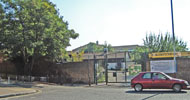
The entrance to the Farm from Rotherhithe Street.

The Farm garden.
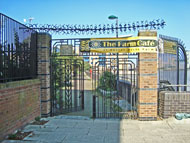
The entrance gateway to the Farm.
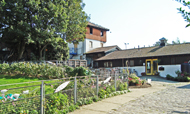
Farm buildings.

Looking across the river roughly along where the pier was sited.
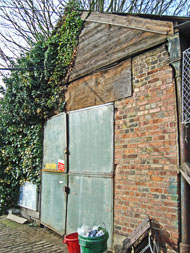
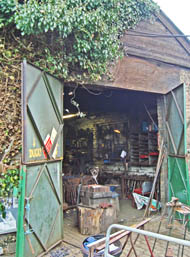
The surviving shed was originally where the smallpox patients were brought for examination before being loaded onto an ambulance steamer.
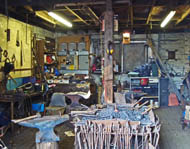
The shed is now the Forge, a working blacksmith's shop offering educational courses for children and adults.
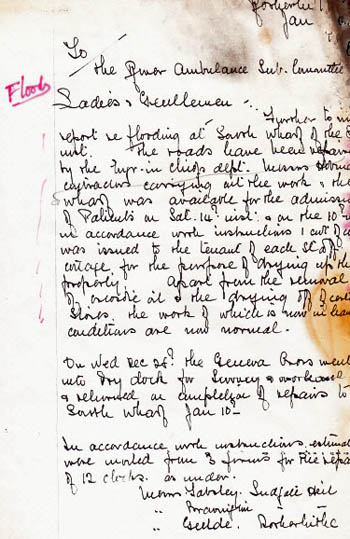
One of the letters stored in the archives at the Surrey Docks Farm. It concerns damage caused by the floods in 1928 (see text below).
(Courtesy of Barry Mason, Manager, Surrey Docks Farm)
|
Rotherhithe
Jan 17th
To/ The River Ambulance Sub CommitteeLadies and Gentlemen, Further to my report re: flooding at South Wharf of the 8th inst. The roads have been repaired by the Engineer-in-Chiefs Dept Messrs Holme contractors carrying out the work and the wharf was available for the admission of Patients on Sat 14th inst. and on the 10th re: in accordance with instructions 1 cwt of coal was issued to the tenant of each staff cottage for the purpose of drying up the property. Apart from the removal of creosote oil and the drying off of central stores the work of which is now in hand conditions are now normal. On Wed Dec 28th the Geneva Cross went into dry dock for survey and overhaul and returned on completion of repairs to South Wharf Jan 10th. In accordance with instructions estimates were invited from 3 firms for the repair of 12 clocks, as under Messrs Labsley, Ludgate Hil
" Bravington, "
" Wilde, Rotherhithe
|
Ayers G 1971 England's First State Hospitals and the MAB 1867-1930. London, Wellcome Institute.
Mortimer PP 2008 Ridding London of smallpox: the aerial transmission debate and the evolution of a precautionary approach. Epidemiology & Infection 136, 1297-1305
Wilson N 1995/6 Ship Ahoy! Metropolitan Asylums Board River Ambulance Service. Unpublished dissertation filed at the Wellcome Library.
www.bexley.gov.uk
www.dartfordhospitalhistories.org.uk
www.portcities.org.uk
www.workhouses.org.uk
Return to home page